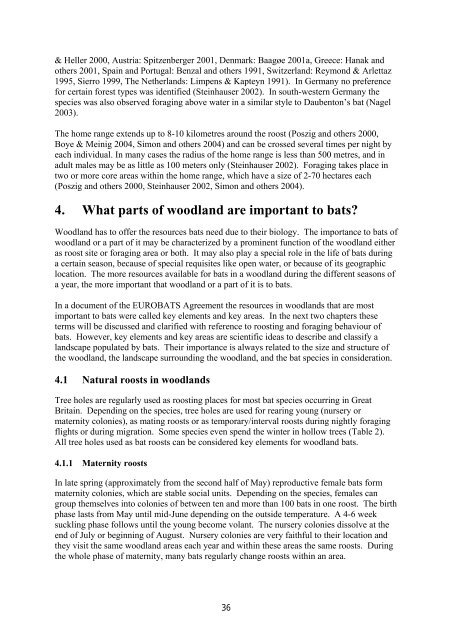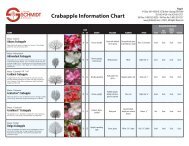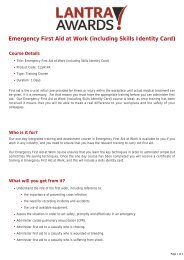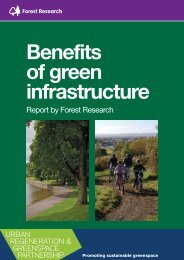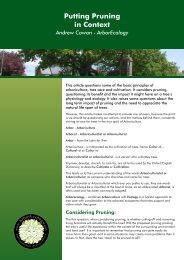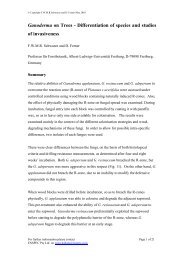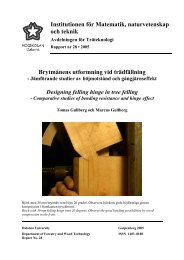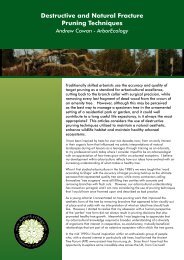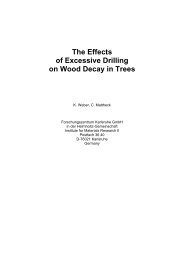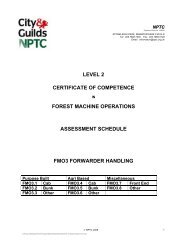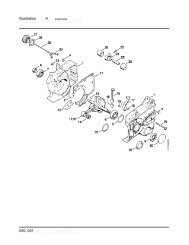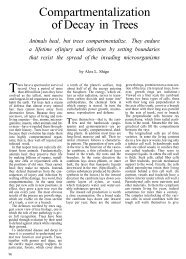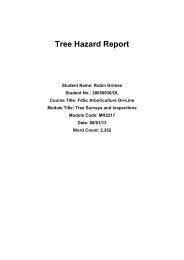working today for nature tomorrow - Justus-Liebig-Universität GieÃen
working today for nature tomorrow - Justus-Liebig-Universität GieÃen
working today for nature tomorrow - Justus-Liebig-Universität GieÃen
- No tags were found...
You also want an ePaper? Increase the reach of your titles
YUMPU automatically turns print PDFs into web optimized ePapers that Google loves.
& Heller 2000, Austria: Spitzenberger 2001, Denmark: Baagøe 2001a, Greece: Hanak andothers 2001, Spain and Portugal: Benzal and others 1991, Switzerland: Reymond & Arlettaz1995, Sierro 1999, The Netherlands: Limpens & Kapteyn 1991). In Germany no preference<strong>for</strong> certain <strong>for</strong>est types was identified (Steinhauser 2002). In south-western Germany thespecies was also observed <strong>for</strong>aging above water in a similar style to Daubenton’s bat (Nagel2003).The home range extends up to 8-10 kilometres around the roost (Poszig and others 2000,Boye & Meinig 2004, Simon and others 2004) and can be crossed several times per night byeach individual. In many cases the radius of the home range is less than 500 metres, and inadult males may be as little as 100 meters only (Steinhauser 2002). Foraging takes place intwo or more core areas within the home range, which have a size of 2-70 hectares each(Poszig and others 2000, Steinhauser 2002, Simon and others 2004).4. What parts of woodland are important to bats?Woodland has to offer the resources bats need due to their biology. The importance to bats ofwoodland or a part of it may be characterized by a prominent function of the woodland eitheras roost site or <strong>for</strong>aging area or both. It may also play a special role in the life of bats duringa certain season, because of special requisites like open water, or because of its geographiclocation. The more resources available <strong>for</strong> bats in a woodland during the different seasons ofa year, the more important that woodland or a part of it is to bats.In a document of the EUROBATS Agreement the resources in woodlands that are mostimportant to bats were called key elements and key areas. In the next two chapters theseterms will be discussed and clarified with reference to roosting and <strong>for</strong>aging behaviour ofbats. However, key elements and key areas are scientific ideas to describe and classify alandscape populated by bats. Their importance is always related to the size and structure ofthe woodland, the landscape surrounding the woodland, and the bat species in consideration.4.1 Natural roosts in woodlandsTree holes are regularly used as roosting places <strong>for</strong> most bat species occurring in GreatBritain. Depending on the species, tree holes are used <strong>for</strong> rearing young (nursery ormaternity colonies), as mating roosts or as temporary/interval roosts during nightly <strong>for</strong>agingflights or during migration. Some species even spend the winter in hollow trees (Table 2).All tree holes used as bat roosts can be considered key elements <strong>for</strong> woodland bats.4.1.1 Maternity roostsIn late spring (approximately from the second half of May) reproductive female bats <strong>for</strong>mmaternity colonies, which are stable social units. Depending on the species, females cangroup themselves into colonies of between ten and more than 100 bats in one roost. The birthphase lasts from May until mid-June depending on the outside temperature. A 4-6 weeksuckling phase follows until the young become volant. The nursery colonies dissolve at theend of July or beginning of August. Nursery colonies are very faithful to their location andthey visit the same woodland areas each year and within these areas the same roosts. Duringthe whole phase of maternity, many bats regularly change roosts within an area.36


